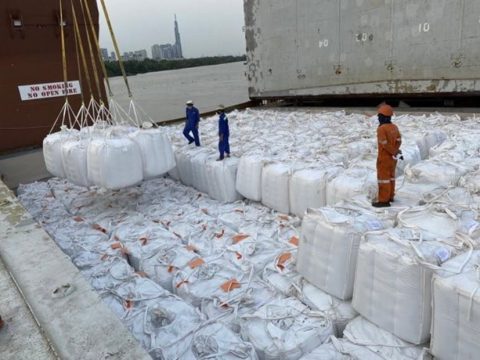
Sucafina’s solution for shipping coffee: Breakbulk
Sucafina, a sustainable “farm to roaster” coffee company, recently became the first company in 30 years to to ship coffee in breakbulk. To address transit times, shipping costs and container shortages, Sucafina explored options that can speed up shipping times and trialled breakbulk shipping.
“We shipped approximately 8,000 metric tons of Vietnam Robusta that was 100% traceable through Farmer Connect,” explains Raphaelle Hemmerlin, head of Logistics and Operational Efficiency. “This is an economical choice for larger roasters moving several tons of coffee from a single origin.”
A brief look into breakbulk shipping
To those who have been in the industry a long time, breakbulk may not be a new concept at all. Before the rise of containerisation in the mid-1950s, breakbulk shipping was the norm. Coffee and all other exports were individually packaged ‘in bulk’ into sacks or boxes and then carefully packed in the hull of a ship like an intricate, 3D puzzle.
When they were introduced, containers brought a lot of benefits. They reduced loading and unloading time, which saved a lot of money and labor hours. Containers also increased protection for perishable cargo by further shielding items from water and other contaminants. These new container advantages meant that breakbulk shipping became the more expensive option and largely disappeared.
“Breakbulk is commonly used to transport goods that cannot fit in standard shipping containers, such as construction equipment and other heavy or oversized goods,” explains Que Mai APAC Exports Logistics Manager for Sucafina.
During the logistics slowdown caused by the coronavirus pandemic, container shortages have caused significant delays in worldwide shipping. In light of this situation, breakbulk shipping has once again become a viable option for transporting coffee.
“What breakbulk does is eases the container freight bottleneck,” says Jordan Hooper, managing director of Sucafina North America. “Breakbulk vessels at peak efficiency are moving 100k+ bags at once. That’s 400 containers that suddenly aren’t needed.”
Hemmerlin emphasises the efficiency of breakbulk in the current environment. “By utilising breakbulk, we have been able to ship a significant quantity of coffee in an operationally efficient manner. This enables Sucafina to continue to serve our customers and partners while helping them navigate any supply chain issues they may be facing.”
Another benefit of breakbulk is that, since the ships are smaller and have limited cargo, ships don’t have many stops to make and often arrive at the destination port much faster. Furthermore, smaller ships eliminate the need for feeder ships, the smaller ships that offload containers and take them to ports that are too small for cargo ships.
Who Can Benefit From Breakbulk?
While breakbulk does bring several benefits, especially in the current logistically challenging environment, it’s not for everyone, Sucafina experts say. At its core, breakbulk means moving a large quantity of coffee – at least 100,000 bags – in a single shipment. The size brings other logistics challenges, including storage.
“Most breakbulk shipments are targeted towards larger commercial roasters who are paying attention to the drop in destination stocks and are concerned with pipeline continuity. They have a business case for landing coffee early and paying for extra storage to ensure availability,” Jordan says. “In our analysis, most of the cost savings on the large shipments are offset by extra storage costs, but that’s acceptable to some roasters in today’s difficult freight environment.”
Furthermore, breakbulk shipping works best in Supersacks, which can hold 275-60kg bags (about 21.6 tons), but most roasters aren’t set up to receive coffee in Supersacks. “The packaging that works best for breakbulk isn’t what works best for roasters who are used to accepting coffee in jute only,” Jordan says.
On the other hand, breakbulk shipping can significantly reduce the overall paperwork and logistics needed to get coffee exported and imported. “You can issue 1 bill of lading and 1 set of documents for the whole vessel,” Que says. Compared to issuing paperwork for each container, this is substantially easier logistics-wise.
Managing Risk
“The risk profile of breakbulk shipments is significantly different (and in some cases significantly higher) when compared to container shipments,” Hemmerlin says. “These risk exposures require a global corporate approach to risk management. They also require elevated communication and transparency with operational partners in order to manage and mitigate counter-party, financial, market and operational risks.”
In order to insure our recent breakbulk shipment, Sucafina supplied extensive information about the ship, stuffing method, cargo value and more, explains Tran Dao, Shared Service Team Leader for Sucafina. “Inspectors were also called to supervise the loading and unloading of the cargo,” she says.
As Sucafina continues to explore breakbulk shipping, the company aims to hone its methods and improve the overall ease and speed with which it ships breakbulk.
Breakbulk shipping isn’t a silver bullet, but it can substantially ease container shortage and logistics issues. With breakbulk, Sucafina is exploring alternative shipping methods that are designed to deliver the coffee to where and when it is needed.
You just read one of our premium articles free of charge
Want full access? Take advantage of our exclusive offer




